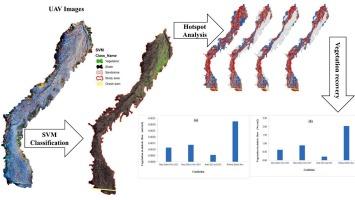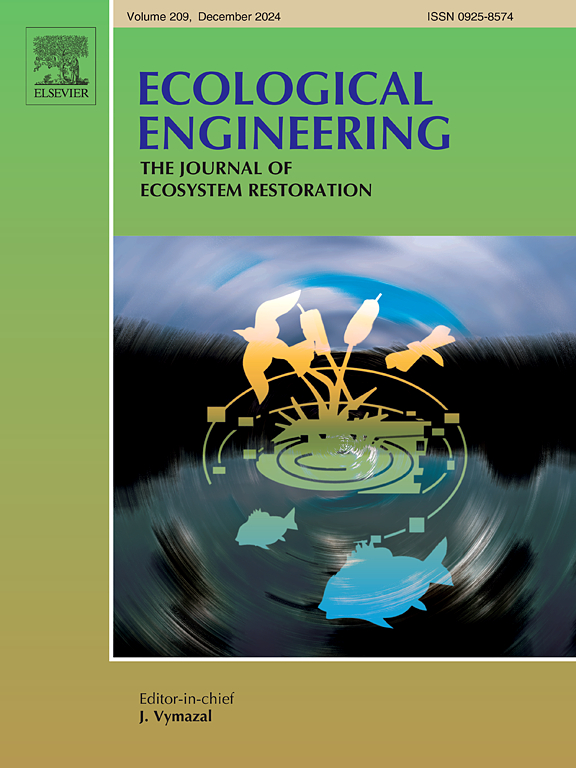评估沉积物特征对泥石流扇植被恢复的影响:日本大谷地区案例研究
IF 3.9
2区 环境科学与生态学
Q1 ECOLOGY
引用次数: 0
摘要
哪些因素会影响泥石流易发区的自然植被恢复,沉积物动力学又是如何发挥作用的?本研究利用各种分析技术,在日本大谷泥石流扇区研究了这些问题。通过应用支持向量机(SVM)分类、粒度分析、精度评估、泥石流分析和热点分析,本研究评估了沉积物的分布、植被等级和泥石流事件的范围。研究结果揭示了植被恢复的动态及其与沉积物动态的关系。SVM 分类结果显示了沉积物和植被沿水流路径分布的明显趋势,尤其注意到从上游到下游地段植被覆盖率的显著下降。通过采用 SVM 分类,本研究成功识别了 3,282,910 个沉积物颗粒,并确定其平均、最小、最大和标准偏差粒度分别为 7.3 厘米、0.27 厘米、415 厘米和 9.18 厘米。图像分类和粒度测量的准确性评估显示出很高的准确性,总体分类准确率为 98.82%,卡帕系数为 0.977。粒度测量的验证结果表明,实地观测到的沉积物粒度与分类图像得出的粒度之间存在很强的相关性(R2 = 0.997,y = 1.005× + 0.0661)。泥石流分析显示,2022 年受泥石流影响的总面积为 36232.7 平方米,2023 年降至 14213.9 平方米。热点分析确定了沉积物大小浓度较高和较低的区域,为了解沉积物分布模式提供了宝贵的信息。本研究通过考察植被的自然恢复情况,确定了不同研究区段的植被点。结果表明,55% 的植被自然恢复区域位于 2022 年至 2023 年间未受泥石流事件影响的区域。在各研究区段中,2023 年受泥石流影响的区域植被点密度最低。总之,本研究强调了新一代植被恢复及其与大屋泥石流扇沉积动态的关联。研究结果为理解高动态沉积区的自然恢复过程提供了宝贵的见解,为泥石流易发区生态系统恢复和管理的有效策略的制定提供了参考。本文章由计算机程序翻译,如有差异,请以英文原文为准。

Assessing the impact of sediment characteristics on vegetation recovery in debris flow fans: A case study of the Ohya Region, Japan
What factors influence natural vegetation recovery in debris flow-prone areas, and how do sediment dynamics play a role? This study investigates these questions in the Ohya debris flow fan, Japan, utilizing various analytical techniques. Through the application of Support Vector Machine (SVM) classification, grain size analysis, accuracy assessment, debris flow analysis, and hotspot analysis, this study assess the distribution of sediments, vegetation classes, and the extent of debris flow events. The findings shed light on the dynamics of vegetation recovery and its relationship with sediment dynamic. The SVM classification outcomes reveal distinct trends in sediment and vegetation distribution along the flow path, particularly noting a significant decrease in vegetation cover from upstream to downstream sections. By employing SVM classification, this study successfully identified 3,282,910 sediment particles and determined their average, minimum, maximum, and standard deviation grain sizes as 7.3 cm, 0.27 cm, 415 cm, and 9.18, respectively. Accuracy assessments of image classification and grain size measurements demonstrate high levels of accuracy, with an overall classification accuracy of 98.82 % and a kappa coefficient of 0.977. Validation of grain size measurements reveals a strong correlation (R2 = 0.997 and y = 1.005× + 0.0661) between field-observed sediment sizes and sizes derived from classified images. Debris flow analysis reveals that the total area affected by debris flow in 2022 was 36,232.7 square meters, decreasing to 14,213.9 square meters in 2023. Hotspot analysis identifies regions of both high and low sediment size concentrations, providing valuable insights into sediment distribution patterns. Examining the natural recovery of vegetation, present study identifies vegetation spots across different study sections. Results show that 55 % of naturally recovering vegetation areas are located in regions unaffected by debris flow events between 2022 and 2023. Among the study sections, the area affected by debris flow in 2023 exhibits the lowest density of vegetation spots. Overall, this study highlights the new generation vegetation recovery and its association with sediment dynamic in the Ohya debris flow fan. The findings contribute valuable insights for understanding natural recovery processes in highly dynamic sedimentation areas, informing the development of effective strategies for ecosystem restoration and management in debris flow-prone regions.
求助全文
通过发布文献求助,成功后即可免费获取论文全文。
去求助
来源期刊

Ecological Engineering
环境科学-工程:环境
CiteScore
8.00
自引率
5.30%
发文量
293
审稿时长
57 days
期刊介绍:
Ecological engineering has been defined as the design of ecosystems for the mutual benefit of humans and nature. The journal is meant for ecologists who, because of their research interests or occupation, are involved in designing, monitoring, or restoring ecosystems, and can serve as a bridge between ecologists and engineers.
Specific topics covered in the journal include: habitat reconstruction; ecotechnology; synthetic ecology; bioengineering; restoration ecology; ecology conservation; ecosystem rehabilitation; stream and river restoration; reclamation ecology; non-renewable resource conservation. Descriptions of specific applications of ecological engineering are acceptable only when situated within context of adding novelty to current research and emphasizing ecosystem restoration. We do not accept purely descriptive reports on ecosystem structures (such as vegetation surveys), purely physical assessment of materials that can be used for ecological restoration, small-model studies carried out in the laboratory or greenhouse with artificial (waste)water or crop studies, or case studies on conventional wastewater treatment and eutrophication that do not offer an ecosystem restoration approach within the paper.
 求助内容:
求助内容: 应助结果提醒方式:
应助结果提醒方式:


